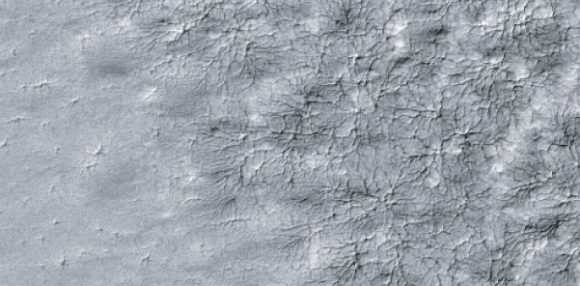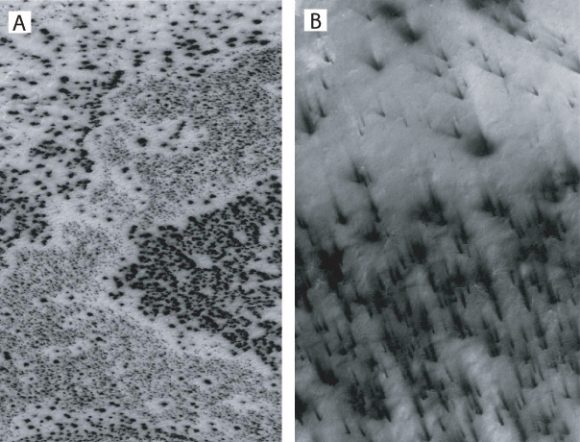For years, scientists have understood that in Mars' polar regions, frozen carbon dioxide (aka. dry ice) covers much of the surface during the winter. During the spring, this ice sublimates in places, causing the ice to crack and jets of CO² to spew forth. This leads to the formation of dark fans and features known as "spiders", both of which are unique to Mars' southern polar region.
For the past decade, researchers have failed to see these features changing from year-to-year, where repeated thaws have led to their growth. However, using data from the Mars Reconnaissance Orbiter's (MRO) HiRISE camera, a research team from the University of Colorado, Boulder and the Planetary Science Institute in Arizona have managed to catch sight of the cumulative growth of a spider for the first time from one spring to the next.
Spiders are so-named because of their appearance, where multiple channels converge on a central pit. Dark fans, on the other hand, are low-albedo patches that are darker than the surrounding ice sheet. For some time, astronomers have been observed these features in the southern polar region of Mars, and multiple theories were advanced as to their origin.

HiRISE images of the Martian landscape, showing outgassing and the formation of dark fans and "spiders". Credit: NASA/JPL
In 2007, Hugh Kieffer of the Space Science Institute in Boulder, Colorado theorized that the dark fans and spiders were linked, and that both features were the result of spring thaws. In short, during Mars' spring season - when the southern polar region is exposed to more sunlight - the Sun's rays penetrates the ice sheets and warm the ground underneath.
This causes gas flows to form beneath the ice that build up pressure, eventually causing the ice to crack and triggering geysers. These geysers deposit mineral dust and sand across the surface downwind from the eruption, while the cracks in the ice grow and become visible from orbit. While this explanation has been widely-accepted, scientists have been unable to observe this process in action.
By using data from the MRO's High Resolution Imaging Science Experiment (HiRISE), the research team was able to spot a small-channeled troughs in the southern region which persisted and grew over a three year period. In addition to closely resembling spidery terrain, it was in proximity to dark fan sites. From this, they determined that they were witnessing a spider that was in the process of formation.
As Dr. Ganna Portyankina - a professor from the Laboratory for Atmospheric and Space Physics at the University of Colorado, Boulder, and the lead author on the team's research paper - explained to Universe Today via email,
"We have observed different changes in the surface caused by CO² jets before. However, they all were either seasonal changes in surface albedo, like dark fans, or they were only short-lived and were gone the next year, like furrows. This time, the troughs have stayed over several years and they develop dendritic-type of extension - right the way we expect the large spiders to develop."

Spiders trace a delicate pattern on top of the residual polar cap, after the seasonal carbon-dioxide ice slab has disappeared. Next spring, these will likely mark the sites of vents when the CO2 icecap returns. This MOC image is about 2 miles wide. Credit: NASA/JPL/MSSS
Furrows that were similar to the spidery terrain have been spotted at Mars' north pole in the past, which coincided with a Martian spring. On these occasions, scientists using data from HiRISE instrument reported seeing small furrows on sand dunes, where eruptions had deposited dark fans. However, in what is typical of northern furrows, these were non-persisting annual occurrences, disappearing when summer winds deposited sand in them.
In contrast, the troughs Dr. Portyankina and her team observed in the southern polar region were persistent over a three-year period. During this time, these features extended and developed new "tributaries", forming a dendritic pattern that resembled a Martian spider. From this, they concluded that the previously-observed northern furrows have the same cause - i.e. sublimation causing outgassing.
However, they also concluded that the northern furrows do not develop over time because of the high-mobility of dune material in the northern polar region. The difference, it seems, comes down to the presence of erosive sand material in the north and south, which creates (or starts) the erosive process that leads to the formation of spider-like troughs - which both kick-stars the process but can also erase it.
"Many locations in the south polar regions with seasonal dark fans show no visible sand deposits," said Dr. Portyankina. "Dark fans in those locations might be only a mix of regolith and dust, or even just dust on its own - as it is really everywhere on Mars... [T]hose locations that have sand will experience higher erosion simply because there is granular material in the gas flow. Basically, it is old simple sandblasting. This means, it must be easier and faster to carve spiders in those locations."

Images of dark spots (left) and fans (right) observed on top of the Martian south polar cap taken in southern spring. Credit: NASA/JPL/MSSS
In other words, where sand exists beneath the ice sheet, the ground beneath that is likely to be rockier (i.e. harder)> The formation of spider terrain may thereofre require that the ground beneath the ice be soft enough to be carved, but not so loose that it will refill the channels during a single seasonal cycle. In short, the formation of spidery terrain appears to be dependent upon the difference in surface composition between the poles.
In addition, from the many year's of HiRISE data that has been accumulated, Dr. Portyankina and her team were also able to gauge the current rate of erosion in Mars' southern polar region. Ultimately, they estimated that smaller spider-like furrows would require a thousand Martian years (about 1,900 Earth years) in order to become a full-scale spider.
This study is certainly significant, since understanding how seasonal changes and present-day erosion lead to the creation of new topographical features is important when it comes to understanding the processes that shape Mars' polar regions. As we get closer and closer to the day when crewed missions and even settlement become a reality, knowing how these processes shape the planet will be fundamental to making a go of things on Mars.
Further Reading: NASA, Icarus







No comments:
Post a Comment